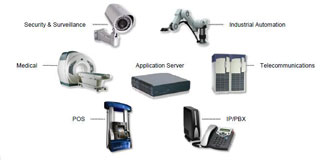REDMOND, Wash. — Nov. 17, 2010 — Last month, the Windows Embedded team posted several stories about Windows Embedded Server’s contribution to industries like security, medical, industrial automation and telecommunications. If you haven’t had a chance to check these out, they give an inside look into several interesting scenarios that you may not have thought Windows Embedded was involved in, such as keeping casino floors secure or controlling on-site factory equipment.
According to VDC Research, by 2015, greater than 10 billion connected devices, like server appliances, will be produced each year. The server appliances market has such a broad set of scenarios, such as those mentioned above, and offers great advantages like quick installation, simple maintenance and high dependability. Server appliances often come packaged with an operating system (OS) — such as Windows Embedded Server — a database, and network access in a custom or “commercial off the shelf” form factor.

By 2015, VDC estimates that greater than 10 billion connected devices, like server appliances, will be produced each year.
“Although interconnectivity has become a given in some applications such as factory automation monitoring or telecommunications infrastructure, many other embedded device classes, however, are just beginning to have the internal resources capable of supporting this next level of functionality,” VDC states in its recent report. “As more and more of these devices are required to incorporate these new features, engineering organizations will be forced to once again reevaluate the build versus buy paradigm.”
A whole new realm of possibilities for platforms like Windows Embedded Server comes to light though Scalable Edge Nodes (SEN) — a new class of hardware platform that incorporates the “density of an appliance with the flexibility of an embedded computer to enable mission-critical applications including control applications and migration to cloud services.” Nonetheless, migrating traditional enterprise-class infrastructure to SEN platforms can be challenging, but end-to-end integrated software frameworks such as those from Microsoft can certainly make things easier.
VDC says that more than 42 percent of projects currently in development are behind scheduled completion date due to changes in specifications, lack of manpower or unrealistic schedules. To assist with this, Windows Embedded Server can help minimize risk to schedule as well as jump-start IT organizations’ development of their application or integration of a vast ecosystem of available applications.
Interested in learning more about the endless opportunities from Windows Embedded Server as we move toward a more connected world? Check out VDC Research’s white paper on server appliances.




